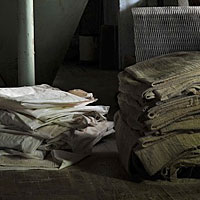How are Hessian Fabrics Produced?
December 11, 2017

At Lowinsacks we firmly believe in the capabilities that Hessian cloth can offer to the packaging industry. That is why, since 1952, our company has been putting out high-quality Hessian fabric bags, totes, sacks and other storage containers for a variety of different industries. From engineering to upholstery, Hessian fabric has been a difference maker. Today, we are going to take a closer look at Hessian fabrics in order to see how they are produced so that you can have a more complete appreciation for the product and what it can do.
Making Hessian Fabric
Known as 'burlap' in North America and 'crocus' in the Caribbean, Hessian fabric has been used throughout much of the world since at least the 17th century. The reason we refer to this material as Hessian fabric is simple, the cloth was used as the primary armour material for Hessian soldiers, men and women from the German state known as Hesse. Now, hundreds of years later, the name has stuck and the branding is complete. Knowing the history of the cloth doesn't help us completely understand how the fabric is produced, but it gives us a clearer picture as to why it was produced. Let us take a closer look at the production process for Hessian fabric.
Hessian fabric is known for being a tough, rugged, and hardy type of material -- and for good reason. Hessian fabric is made from all-natural plant fibres pulled from the jute plant. Jute plants are long, stalk-like vegetable stalks that can be broken down rather easily. This is a large reason as to why Hessian fabric took off at such an astronomical pace, quickly spreading around the entire world thanks to the East India Trading Company. The fibres pulled from the Jute plant are roughly spun into the end-product that you see on our shelves today.
People have been routinely turning to the Jute plant in order to make Hessian fabric because the material is incredibly durable and hardy. Hessian fabric has its use in a variety of different industries, as we pointed out above, for a variety of different reasons. Many industries want to push toward eco-friendly packaging alternatives and that is largely one of the biggest reasons that Hessian fabric remains so popular. Hessian fabric is all-natural, more eco-friendly than a disposable bag, and more long-lasting as a result.
Whether you need Hessian sacks or cloth for your agriculture business or for your upholstery job, here at Lowinsacks we can help lead you to the right product for the job.
Optimized by NetwizardSEO.com.au
Posts 2018
Posts 2017
- How are Hessian Fabrics Produced?
- A Brief History of Hessian Fabric
- Benefits of Using Hessian Fabric for Christmas Decorations
- Fabric Painting Using Hessian Cloth
- Is Hessian Fabric Flammable?
- Polypropylene: What Makes This Plastic Sustainable?
- Cute Hessian Ribbon Ideas for Scrapbook Decorations
- Hessian Fabric for Your Home Window Treatments
- Why Jute Bags are Considered as Earth-Friendly
- Calico Drawstring Bags for Laundry Use
- Party Fun and Game Ideas Using Hessian Sacks
- Hessian Cloth and Lace Design Ideas for the Home
- Why Woven Polypropylene Bags are Suitable for Packaging
- Qualities of Woven Polypropylene Bags
- Differences between Woven Polypropylene and Hessian Sacks
- Versatile Uses of Hessian Sandbags
- Top 5 Reasons Why We Should Go for Sustainable Packaging and Get Rid of Plastic
- Different Ways of Designing Your Calico Bags
- Eco-Friendly Properties of Hessian Fabric
- Differences between Cotton and Jute Bags?
- How to Spot Superior Quality Hessian Cloth
- Why Is It Ideal for Vegetables and Fruit Produce to Be Inside Hessian Sacks Instead of Plastic?
- Clean and Green Packaging without the Plastic Materials
- Hessian Fabric for Upholstery
Posts 2016
- Various Handcrafted Products That Can Be Made From Hessian Fabric
- Why Should Supermarkets Use Recyclable Bags Instead of Plastic Bags?
- View all articles…